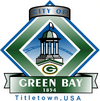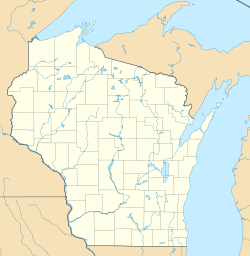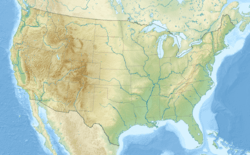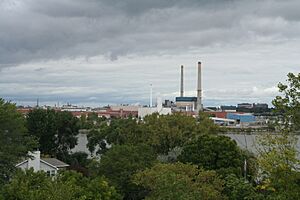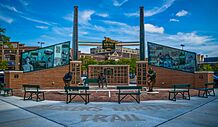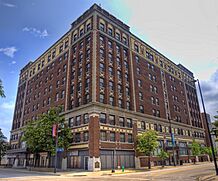Green Bay, Wisconsin facts for kids
Quick facts for kids
Green Bay
|
|||
|---|---|---|---|
|
|
|||
|
|||
| Nicknames:
"Titletown", "Bayland", "Bay City", "Packerland", and "Packer City"
|
|||
| Country | |||
| State | |||
| County | Brown | ||
| Area | |||
| • City | 55.76 sq mi (144.42 km2) | ||
| • Land | 45.48 sq mi (117.80 km2) | ||
| • Water | 10.28 sq mi (26.62 km2) | ||
| Elevation | 581 ft (177 m) | ||
| Population
(2020)
|
|||
| • City | 107,395 | ||
| • Estimate
(2024)
|
106,311 | ||
| • Rank | US: 306th, WI: 3rd | ||
| • Density | 2,299.38/sq mi (887.79/km2) | ||
| • Urban | 224,156 (US: 175th) | ||
| • Urban density | 1,972.2/sq mi (761.5/km2) | ||
| • Metro | 320,050 (US: 157th) | ||
| GDP | |||
| • Metro | $24.565 billion (2022) | ||
| Time zone | UTC−6 (Central) | ||
| • Summer (DST) | UTC−5 (CDT) | ||
| ZIP code |
54301-08, 54311, 54313, 54324, 54344
|
||
| Area code | 920 | ||
| FIPS code | 55-31000 | ||
| GNIS feature ID | 1565801 | ||
Green Bay is a city in Wisconsin, located where the Fox River flows into Lake Michigan. It is the third-largest city in the state, with a population of 107,395 as of the 2020 census. Green Bay is famous around the world as the home of the Green Bay Packers football team.
The city's location on the water has made it an important center for industry and shipping for hundreds of years. Today, Green Bay is known for its manufacturing, healthcare, and services, in addition to its strong connection to its historic football team.
Contents
History of Green Bay
Early European Settlement
In 1634, French explorer Jean Nicolet arrived in the Green Bay area. He was sent by Samuel de Champlain, the founder of New France (the name for France's colonies in North America), to build peaceful relationships with Native American tribes and to look for a trade route to Asia.
When Nicolet arrived, he met the Menominee and Ho-Chunk (also known as Winnebago) people. These tribes were skilled at hunting, fishing, and farming crops like corn, beans, and squash. Nicolet started a small fur trading post, which was one of the first European settlements in what is now the United States. The French first called the area La Baie des Puants, which means "the Bay of Stinking Waters," but later changed it to La Baie Verte, meaning "The Green Bay."

For many years, the area was a key part of the French fur trade. In 1754, a town was officially started.
British and American Control
After the French and Indian War, Great Britain took control of the area in 1761. The British were also interested in the fur trade. One of the first permanent European settlers was Charles Michel de Langlade, who was part French-Canadian and part Ottawa tribe. He is often called the "Father of Wisconsin."
After the American Revolutionary War, the United States gained control of the territory in 1783. In 1816, the U.S. Army built Fort Howard to protect the area.
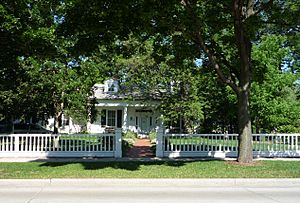
Growth of a City
The opening of the Erie Canal in 1825 made it easier for people from the eastern United States, especially New England, to move to Wisconsin. Green Bay grew quickly as a trading center. The city of Green Bay was officially incorporated in 1854.
In the 1800s, many immigrants from European countries like Belgium, Germany, Ireland, and Scandinavia moved to Green Bay. They started farms and businesses, adding to the city's culture. The lumber and paper industries became very important. The first paper mill was built in 1865, starting an industry that would become a major part of Green Bay's identity.
In 1919, the Green Bay Packers football team was founded, connecting the city to the National Football League and making it famous across the country.
Geography and Climate
Green Bay is located in eastern Wisconsin at the mouth of the Fox River. The city sits on an inlet of Lake Michigan that is also called Green Bay.
The city has a humid continental climate, which means it has four distinct seasons. Summers are warm and sometimes humid, while winters are cold and very snowy. The weather can change a lot from one season to the next.
| Weather chart for Green Bay | |||||||||||||||||||||||||||||||||||||||||||||||
|---|---|---|---|---|---|---|---|---|---|---|---|---|---|---|---|---|---|---|---|---|---|---|---|---|---|---|---|---|---|---|---|---|---|---|---|---|---|---|---|---|---|---|---|---|---|---|---|
| J | F | M | A | M | J | J | A | S | O | N | D | ||||||||||||||||||||||||||||||||||||
|
35
-4
-12
|
30
-2
-10
|
50
5
-5
|
76
12
2
|
85
20
8
|
104
25
13
|
92
27
16
|
86
26
15
|
81
22
10
|
68
14
4
|
50
6
-2
|
44
-1
-8
|
||||||||||||||||||||||||||||||||||||
| temperatures in °C precipitation totals in mm |
|||||||||||||||||||||||||||||||||||||||||||||||
|
Imperial conversion
|
|||||||||||||||||||||||||||||||||||||||||||||||
| Climate data for Green Bay, Wisconsin (Austin Straubel Int'l), 1991–2020 normals, extremes 1886–present | |||||||||||||
|---|---|---|---|---|---|---|---|---|---|---|---|---|---|
| Month | Jan | Feb | Mar | Apr | May | Jun | Jul | Aug | Sep | Oct | Nov | Dec | Year |
| Record high °F (°C) | 56 (13) |
70 (21) |
82 (28) |
89 (32) |
99 (37) |
101 (38) |
104 (40) |
100 (38) |
97 (36) |
88 (31) |
75 (24) |
65 (18) |
104 (40) |
| Mean maximum °F (°C) | 43.2 (6.2) |
46.6 (8.1) |
62.1 (16.7) |
76.7 (24.8) |
85.3 (29.6) |
90.2 (32.3) |
90.9 (32.7) |
89.3 (31.8) |
86.1 (30.1) |
77.9 (25.5) |
61.8 (16.6) |
47.8 (8.8) |
93.4 (34.1) |
| Mean daily maximum °F (°C) | 25.5 (−3.6) |
29.0 (−1.7) |
40.4 (4.7) |
53.8 (12.1) |
67.1 (19.5) |
76.6 (24.8) |
81.0 (27.2) |
78.9 (26.1) |
71.7 (22.1) |
58.0 (14.4) |
43.5 (6.4) |
31.1 (−0.5) |
54.7 (12.6) |
| Daily mean °F (°C) | 18.3 (−7.6) |
21.1 (−6.1) |
32.1 (0.1) |
44.3 (6.8) |
56.5 (13.6) |
66.4 (19.1) |
70.5 (21.4) |
68.6 (20.3) |
61.0 (16.1) |
48.7 (9.3) |
36.2 (2.3) |
24.5 (−4.2) |
45.7 (7.6) |
| Mean daily minimum °F (°C) | 11.1 (−11.6) |
13.2 (−10.4) |
23.9 (−4.5) |
34.8 (1.6) |
46.0 (7.8) |
56.2 (13.4) |
60.1 (15.6) |
58.2 (14.6) |
50.2 (10.1) |
39.5 (4.2) |
28.9 (−1.7) |
18.0 (−7.8) |
36.7 (2.6) |
| Mean minimum °F (°C) | −11.3 (−24.1) |
−9.6 (−23.1) |
1.5 (−16.9) |
21.8 (−5.7) |
32.1 (0.1) |
42.2 (5.7) |
49.4 (9.7) |
46.2 (7.9) |
35.0 (1.7) |
25.4 (−3.7) |
12.2 (−11.0) |
−4.7 (−20.4) |
−15.7 (−26.5) |
| Record low °F (°C) | −36 (−38) |
−33 (−36) |
−29 (−34) |
7 (−14) |
21 (−6) |
32 (0) |
40 (4) |
38 (3) |
24 (−4) |
8 (−13) |
−12 (−24) |
−27 (−33) |
−36 (−38) |
| Average precipitation inches (mm) | 1.39 (35) |
1.20 (30) |
1.96 (50) |
3.00 (76) |
3.35 (85) |
4.10 (104) |
3.62 (92) |
3.39 (86) |
3.20 (81) |
2.67 (68) |
1.98 (50) |
1.75 (44) |
31.61 (803) |
| Average snowfall inches (cm) | 14.3 (36) |
12.0 (30) |
8.1 (21) |
4.7 (12) |
0.0 (0.0) |
0.0 (0.0) |
0.0 (0.0) |
0.0 (0.0) |
0.0 (0.0) |
0.3 (0.76) |
3.1 (7.9) |
13.1 (33) |
55.6 (141) |
| Average extreme snow depth inches (cm) | 9.3 (24) |
10.0 (25) |
7.3 (19) |
2.5 (6.4) |
0.0 (0.0) |
0.0 (0.0) |
0.0 (0.0) |
0.0 (0.0) |
0.0 (0.0) |
0.1 (0.25) |
1.4 (3.6) |
7.5 (19) |
13.2 (34) |
| Average precipitation days (≥ 0.01 in) | 10.8 | 8.9 | 10.4 | 11.7 | 12.4 | 11.1 | 10.7 | 10.2 | 9.7 | 10.4 | 9.6 | 10.5 | 126.4 |
| Average snowy days (≥ 0.1 in) | 10.3 | 8.4 | 6.3 | 2.9 | 0.1 | 0.0 | 0.0 | 0.0 | 0.0 | 0.4 | 3.5 | 8.9 | 40.8 |
| Average relative humidity (%) | 74.0 | 73.5 | 72.8 | 67.0 | 65.9 | 68.9 | 71.3 | 75.1 | 76.5 | 74.4 | 76.9 | 77.3 | 72.8 |
| Mean monthly sunshine hours | 146.7 | 159.8 | 198.6 | 222.1 | 285.1 | 302.8 | 314.5 | 278.7 | 205.2 | 158.0 | 107.4 | 112.3 | 2,491.2 |
| Percent possible sunshine | 51 | 55 | 54 | 55 | 62 | 65 | 67 | 64 | 55 | 46 | 37 | 41 | 54 |
| Source: NOAA (relative humidity and sun 1961–1990) | |||||||||||||
People and Population
| Historical population | |||
|---|---|---|---|
| Census | Pop. | %± | |
| 1860 | 2,275 | — | |
| 1870 | 4,698 | 106.5% | |
| 1880 | 7,476 | 59.1% | |
| 1890 | 9,069 | 21.3% | |
| 1900 | 23,748 | 161.9% | |
| 1910 | 25,216 | 6.2% | |
| 1920 | 31,643 | 25.5% | |
| 1930 | 37,407 | 18.2% | |
| 1940 | 46,205 | 23.5% | |
| 1950 | 52,735 | 14.1% | |
| 1960 | 62,952 | 19.4% | |
| 1970 | 87,829 | 39.5% | |
| 1980 | 87,947 | 0.1% | |
| 1990 | 96,466 | 9.7% | |
| 2000 | 102,313 | 6.1% | |
| 2010 | 104,057 | 1.7% | |
| 2020 | 107,395 | 3.2% | |
| 2024 (est.) | 106,311 | 2.2% | |
| U.S. Decennial Census | |||
As of 2020, over 107,000 people live in Green Bay. The city is home to people from many different backgrounds. The largest groups include people of European descent (especially German), Hispanic and Latino people, Native Americans, Asian Americans (including a large Hmong community), and African Americans. The diverse population contributes to the city's rich culture.
Economy
Green Bay has a long history of making paper products. It was once known as the "Toilet Paper Capital of the World" because companies like Northern Paper Company (which created Quilted Northern) started here. The paper industry is still important today, with large companies like Georgia-Pacific and Procter & Gamble.
Meatpacking has also been a major industry since the early days of the city. Today, companies like JBS S.A. and American Foods Group are large employers.
Other important parts of Green Bay's economy include healthcare, trucking and shipping, and insurance. The top employers in the city include Bellin Health, Schneider National (a trucking company), and Humana. The Green Bay Packers also bring a lot of business and tourism to the city.
Arts and Culture
Green Bay has a lively arts and culture scene. The city has several historic theaters, including the Meyer Theatre and the Tarlton Theatre, which host concerts, plays, and film festivals.
Museums in the area include the Neville Public Museum, which focuses on local history, science, and art, and the National Railroad Museum.
During the summer, downtown Green Bay hosts many events. These include ArtStreet, a large art festival, and farmer's markets. There are also many outdoor concerts and food festivals for people to enjoy.
Fun Places to Visit
- Bay Beach Amusement Park: A classic amusement park with a famous wooden roller coaster.
- Bay Beach Wildlife Sanctuary: A large nature reserve where you can see and learn about animals.
- The Broadway District: A historic downtown area with shops, restaurants, and a weekly farmer's market.
- Green Bay Botanical Garden: Beautiful gardens with plants from around the world.
- Lambeau Field: The famous home of the Green Bay Packers. Fans can take tours of the stadium.
- National Railroad Museum: One of the largest railroad museums in the United States.
- Packers Heritage Trail: A walking tour that takes you to important spots in Packers history.
- Fox River State Recreational Trail: A trail for walking, running, and biking along the Fox River.
Sports
Green Bay is best known for the Green Bay Packers, one of the oldest and most successful teams in the National Football League (NFL). The team is unique because it is owned by its fans. Home games at Lambeau Field are a huge part of life in the city.
The city is also home to other sports teams.
| Club | Sport | Founded | Current League | Stadium |
|---|---|---|---|---|
| Green Bay Packers | American Football | 1919 | National Football League | Lambeau Field |
| Green Bay Blizzard | Indoor American football | 2003 | Indoor Football League | Resch Center |
| Green Bay Phoenix (University of Wisconsin-Green Bay) |
15 varsity teams | 1965 | Horizon League | Resch Center, Kress Events Center, Aldo Santaga Stadium |
| St. Norbert Green Knights (St. Norbert College) |
18 varsity teams | 1898 | Northern Athletics Collegiate Conference and Northern Collegiate Hockey Association | Schneider Stadium, Mel Nicks Sports Complex, Schuldes Center, Cornerstone Community Ice Center |
| Green Bay Rockers | Summer college baseball | 2007 | Northwoods League | Capital Credit Union Park |
| Green Bay Gamblers | Junior ice hockey | 1994 | United States Hockey League | Resch Center |
Government
Green Bay is run by a mayor, who is elected by all the city's voters, and a city council. The council has 12 members, and each member represents a different district, or neighborhood, of the city. The mayor and council work together to make decisions and laws for Green Bay.
Education
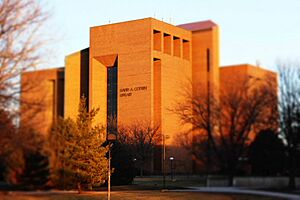
Most students in Green Bay attend schools in the Green Bay Area Public School District. The district has many elementary, middle, and high schools. East High School and West High School have the longest-running high school football rivalry in Wisconsin, with games played since 1905.
For higher education, the city is home to the University of Wisconsin–Green Bay. There are also other colleges in the area, including Northeast Wisconsin Technical College.
Transportation
People can travel to and from Green Bay by car, bus, or airplane. The main airport is Green Bay–Austin Straubel International Airport. Green Bay Metro runs the city's bus system.
Several major highways pass through Green Bay, including Interstate 43 and Interstate 41. The Port of Green Bay is an important shipping hub on the Great Lakes, moving goods like coal, salt, and cement.
Major Highways
 I-43 connects Green Bay to Milwaukee.
I-43 connects Green Bay to Milwaukee. I-41 connects Green Bay to Appleton and Milwaukee.
I-41 connects Green Bay to Appleton and Milwaukee. US 41 runs north to Michigan's Upper Peninsula.
US 41 runs north to Michigan's Upper Peninsula. US 141 also runs north into Michigan.
US 141 also runs north into Michigan. WIS 29 is a major east-west highway.
WIS 29 is a major east-west highway. WIS 32 runs north-south through eastern Wisconsin.
WIS 32 runs north-south through eastern Wisconsin. WIS 54 runs east-west through the city.
WIS 54 runs east-west through the city. WIS 57 connects Green Bay to Sturgeon Bay and Door County.
WIS 57 connects Green Bay to Sturgeon Bay and Door County.
Notable people
Sister city
 Irapuato, Guanajuato, Mexico (since 2006)
Irapuato, Guanajuato, Mexico (since 2006)
See also
 In Spanish: Green Bay para niños
In Spanish: Green Bay para niños









